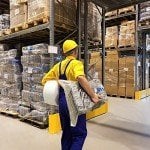Elon Musk of Tesla Motors presented his company’s home battery, called Powerwall, on May 1. Powerwall charges using electricity generated from solar panels which could be mounted on the roof of a typical home. When the sun is not shining, a home with a Powerwall can use the stored energy. It is, as Musk says, a very simple idea.
Simple it may be, but his energy storage solution happens to be the first commercially available system capable of powering a household, though the cost, at $3,500, is likely too high for most consumers at this time. Powerwall comes in two models, one with 10 kWh capacity, the other with 7 kWh. Tesla is also working with utility companies. A special 100 kWh “power pack” can be used by power companies as a buffer when feed-in power from wind or solar is low. Several of Tesla’s utility-scale batteries are already deployed in California.
Musk’s stated goal in developing the Powerwall is to change the way the world uses energy, especially to wean consumers from fossil fuels. One way the company foresees consumers using the Powerwall is as an off-grid backup during peak cost times. Rather than paying premium prices for peak power, consumers could switch to the Powerwall for several hours at a time and save themselves a sizeable amount on their electricity bills. It could also be used in emergencies, such as power outages.
There has already been speculation that a home-scale battery like the Powerwall could mean the end of the nuclear industry, and of the grid in general. As solar and wind power become cheaper and more prevalent, and with an economical way of storing energy in the home becoming a reality, the need for power grids decreases. Investors have been talking about the looming “death spiral” of utilities for several years now, even before the Tesla announcement.
Ultimately it will depend on economics. Can an individual get the power he needs from some combination of wind and solar, in conjunction with a Tesla battery, for less than it currently costs to buy it from the grid? The cost of peak-period power in Ontario as of May 1 is 11 cents per kWh. In his presentation, Musk did not discuss the cost per kWh to use his Powerwall, but it has been reported in Forbes that it would be 2 cents. In the United States, the cost of wind power is reportedly as low as 2.5 cents per kilowatt hour, while solar is on target for 4 cents in a few years. Assuming a cost of 2 cents for the battery and 7 or 8 cents for the solar, we are certainly in the realm of feasibility for household use in Ontario.


































